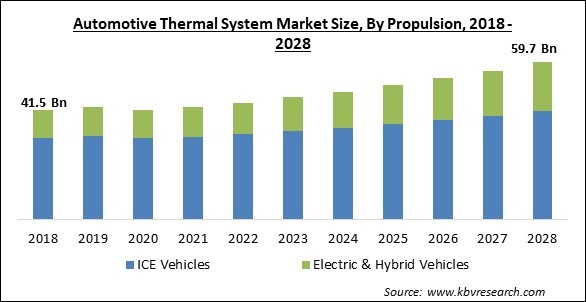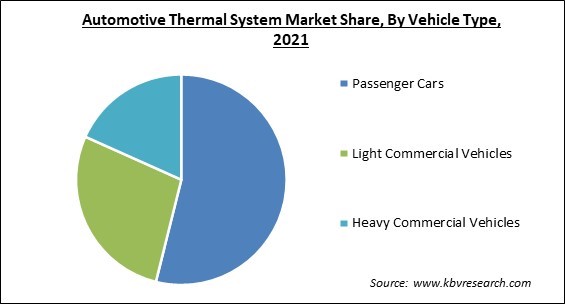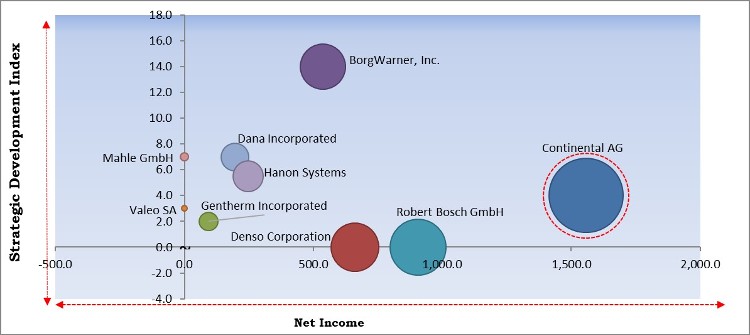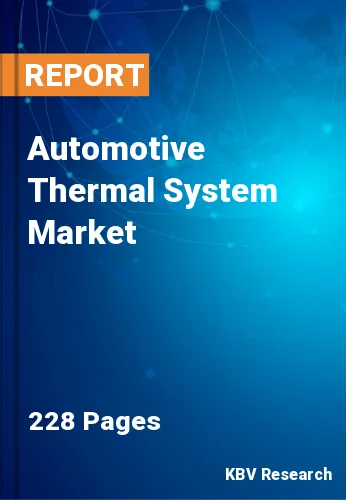The Global Automotive Thermal System Market size is expected to reach $59.7 billion by 2028, rising at a market growth of 5.0% CAGR during the forecast period.
Automotive thermal system is a system that regulates and controls the temperature of prime automotive components through alternative engine block monitoring temperatures and reduced temperature component fluctuations. It regulates the temperature of numerous components in automobiles, including the battery, motor, and cabin, to improve performance, fuel economy, and comfort. Through seat heaters, front air-conditioning system, and rear air conditioning, improved heat management allows automotive components to work in the optimal temperature range while also providing greater comfort in the vehicle interior.
The demand for this technology would surge as more people choose electric vehicles as a result of increasing concern for the environment and the enforcement of strict emission standards as well as rising prices of fuels. Electric vehicles are adopted by several countries throughout the world to meet their net zero-emission targets. Furthermore, incorporating a thermal system into an electric vehicle improves battery performance and effective range. In addition, the automotive industry is emphasizing the need for greater driving qualities and heat shielding for cabin comfort. Due to heat dissipation, the ever-increasing number of electrical components within vehicles needs stronger thermal management systems.
Automobile manufacturers across the world are focusing on the development of electric and hybrid vehicles. Several manufacturers have started to produce electrical equipment such as electric compressors and battery cooling equipment for electric and hybrid vehicles in the context of electric vehicles. For example, Johnson Electric introduced a high-power electric compressor in August 2021, which helps to reduce heat produced by the batteries while high-rate fast-charging stations for electric vehicles.

The COVID-19 crisis caused market uncertainty, a severe slowdown in the supply chain, a drop in corporate confidence, and an increase in panic among client segments. Governments in various regions imposed complete lockdown as well as temporary suspension of operations among organizations, negatively impacting overall automobile thermal system production and sales. In addition, the supply chain disruptions caused by the pandemic resulted in a shutdown of automotive production facilities, which caused poor passenger car sales around the world.
The automobile industry all over the world has shifted its focus toward producing efficient, inexpensive, long-range battery-powered passenger cars that can compete with and eventually replace fossil-fuel vehicles in recent years. However, the design of battery electric vehicles (BEVs) and the infrastructure requirements for mixed and plug-in hybrid and electric vehicles are being developed. Fast charging methods would also aid in the development of long-range batteries with easy access to charging infrastructure. It's crucial that auxiliary loads like cabin heating and cooling, and electric car components, do not degrade vehicle range. Because the amount of wasted heat energy in BEVs is so minimal, these cars demand more efficient auxiliary systems.
Luxury automobiles come with high levels of safety and modern technology. They are equipped with features such as heated and cold airbags, seats, and heated steering wheels. The demand for luxury vehicles has increased as disposable income and living standards have improved. Advanced thermal systems are being integrated into luxury automobiles to enhance performance and energy efficiency. As a result, the automotive thermal system market is projected to grow at a rapid pace. The electric grid and its automotive integrated thermal management system have received broad attention as essential components of modern vehicle technology are pursuing high performance and lightweight in automobile design.
Local or regional producers must adhere to the regulating body's emission regulations or norms. However, since emission restrictions vary according to the area and region, a lack of standardization might make it difficult to export thermal systems. In addition, emission reduction is required in numerous developed and underdeveloped countries. In undeveloped countries, however, such regulation does not exist. As a result of the absence of standardization, producers are unable to source raw materials or inventory, hampering the export business. Low-volume production by manufacturers results in high production costs. Engine technology must be upgraded according to the particular standards that are imposed by the administration of the country.

Based on Propulsion, the market is segmented into ICE Vehicles and Electric & Hybrid Vehicles. The ICE segment acquired the highest revenue share in the Thermal System Market in 2021. The rising growth of this segment is attributed to the fact that internal combustion engines (ICE) are the most popular type of heat engine, with applications in ships, boats, aero planes, trains, and automobiles. They are increasingly gaining popularity because gas is burned for the engine to run. The same fuel and air mixture is ejected as exhaust. A piston or a turbine can be used to accomplish this. Internal combustion heat engines are based on the ideal gas law, which states that increasing the temperature of gas raises the pressure, causing the gas to expand. In an internal combustion engine, fuel is introduced to a chamber, which ignites to enhance the temperature of the gas.
Based on Application, the market is segmented into HVAC, Powertrain Cooling, Fluid Transport, and Others. The Powertrain Cooling segment witnessed a significant revenue share in the Automotive Thermal System Market in 2021. Thermal management is important for reducing emissions, increasing efficiency, and extending the range of conventional combustion, hybrid, and electric vehicles. Its primary role is temperature management in the engine cooling system, but it also controls the temperature of many other components in the drive train, including turbo cooling, gearbox cooling, transmission cooling, and indoor temperature. Because the thermal module is adjacent to the engine, it must operate over a wide temperature range of -40°C to 160°C without leaking. In addition, for accurate valve control, very minimal friction and no stick-slip are necessary. Due to this, the demand for this segment is increasing.
Based on Vehicle Type, the market is segmented into Passenger Cars, Light Commercial Vehicles, and Heavy Commercial Vehicles. The passenger car segment garnered the largest revenue share in the Automotive Thermal System Market in 2021. The increasing growth of this segment is attributed to the increased penetration of sophisticated comfort features, strict government requirements for vehicle emissions, and advancements in thermal system solutions. In addition, increased per capita disposable income and a higher standard of living are two major reasons driving passenger car sales in many countries. Moreover, the market is likely to be driven by a growing demand for comfort and luxury, as well as increased demand for advanced amenities such as heated steering, heated/ventilated seats, and rear air conditioning.
| Report Attribute | Details |
|---|---|
| Market size value in 2021 | USD 42.8 Billion |
| Market size forecast in 2028 | USD 59.7 Billion |
| Base Year | 2021 |
| Historical Period | 2018 to 2020 |
| Forecast Period | 2022 to 2028 |
| Revenue Growth Rate | CAGR of 5% from 2022 to 2028 |
| Number of Pages | 227 |
| Number of Tables | 354 |
| Report coverage | Market Trends, Revenue Estimation and Forecast, Segmentation Analysis, Regional and Country Breakdown, Competitive Landscape, Companies Strategic Developments, Company Profiling |
| Segments covered | Propulsion, Vehicle Type, Application, Region |
| Country scope | US, Canada, Mexico, Germany, UK, France, Russia, Spain, Italy, China, Japan, India, South Korea, Singapore, Malaysia, Brazil, Argentina, UAE, Saudi Arabia, South Africa, Nigeria |
| Growth Drivers |
|
| Restraints |
|
Based on Regions, the market is segmented into North America, Europe, Asia Pacific, and Latin America, Middle East & Africa. In 2021, Asia Pacific procured the largest revenue share in the Automotive Thermal System Market. The rising growth of this region is owing to the growth of the region as a manufacturing hub for automobiles. OEMs have increased automotive manufacturing in the region due to evolving consumer demands, rising middle-class per capita income, and cost benefits. As a result, automobile production in India, China, and Japan has increased significantly. The region's vast vehicle production presents major great potential for the automotive thermal system market. The Asia Pacific is also a suitable market for automobile OEMs due to the favorable investing and the availability of low-cost labor. In this region, increased demand for premium cars with improved cabin comfort has boosted the consumption of automotive thermal systems.
Free Valuable Insights: Global Automotive Thermal System Market size to reach USD 59.7 Billion by 2028

The major strategies followed by the market participants are Acquisitions. Based on the Analysis presented in the Cardinal matrix; Continental AG is the major forerunner in the Automotive Thermal System Market. Companies such as BorgWarner, Inc., Dana Incorporated and Mahle GmbH are some of the key innovators in the Market.
The market research report covers the analysis of key stake holders of the market. Key companies profiled in the report include BorgWarner, Inc., Robert Bosch GmbH, Continental AG, Denso Corporation, Dana Incorporated, Valeo SA, Hanon Systems, Mahle GmbH, Gentherm Incorporated, and Grayson Automotive Services Limited.
By Propulsion
By Application
By Vehicle Type
By Geography
The global automotive thermal system market size is expected to reach $59.7 billion by 2028.
Electric vehicle demand is on the rise are increasing are driving the market in coming years, however, the lack of consistency in automotive thermal system the growth of the market.
BorgWarner, Inc., Robert Bosch GmbH, Continental AG, Denso Corporation, Dana Incorporated, Valeo SA, Hanon Systems, Mahle GmbH, Gentherm Incorporated, and Grayson Automotive Services Limited.
The expected CAGR of the automotive thermal system market is 5% from 2022 to 2028.
The HVAC segment acquired maximum revenue share in the Global Automotive Thermal System Market by Application in 2021; thereby, achieving a market value of $22.6 billion by 2028.
The Asia Pacific market dominated the Global Automotive Thermal System Market by Region in 2021, and would continue to be a dominant market till 2028.
Our team of dedicated experts can provide you with attractive expansion opportunities for your business.

